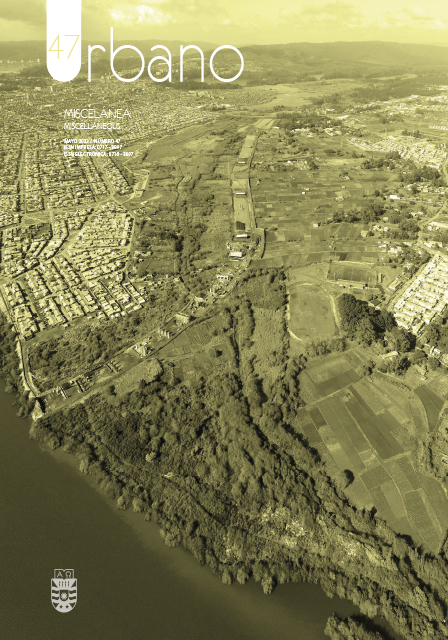The production of socio-spatial injustice towards the Romani population during the franco regime: The neighborhoods of Lo Campano and los Mateos in Cartagena (Spain)
DOI:
https://doi.org/10.22320/07183607.2023.26.47.02Keywords:
anti-Romani, socio-spatial injustice, urban planning, necropoliticsAbstract
62.8% of the Romani population in Spain lives in settlements that are segregated from the urban center or in peripheral neighborhoods, a sign of their historical persecution and discrimination. Anti-Romani sentiment has been territorialized by eliminating autonomy and means of self-production of space, with urban planning and housing policies being a key element in the materialization of their urban segregation, particularly during the Franco regime. Identifying the Romani as a surplus element in urban space led to their expulsion from self-produced housing, relocating them to peripheral social housing neighborhoods. Through the case studies, this article analyzes the Lo Campano and Los Mateos neighborhoods in Cartagena, Spain, the production of socio-spatial injustice against the Romani during Franco's regime, using Nancy Fraser's (1996) definition of social justice, and Giddens' (1994) structuration theory, as an analytical framework. The results indicate that these policies formed the basis of an urban and housing necropolitical exercise against the Romani, identifying them as surplus to the urban space and expelling them from their self-built homes to peripheral social housing.
Downloads
References
Alliance Against Antigypsyism. (2017). Antigypsyism – A Reference Paper. Dimensions of Antigypsyism in Europe, June, 261–275.
ÁLVAREZ DE ANDRÉS, E. (2020). Necropolítica de vivienda: 40 años desmantelando la “informalidad” en Madrid (1979-2019). Eure, 46(139), 5–27. DOI: https://doi.org/10.4067/S0250-71612020000300005
ÁLVAREZ DE ANDRÉS, E., CABRERA, C., & SMITH, H. (2019). Resistance as resilience: A comparative analysis of state-community conflicts around self-built housing in Spain, Senegal and Argentina. Habitat International, 86, 116–125. DOI: https://doi.org/10.1016/j.habitatint.2019.03.003
Ayuntamiento de Cartagena. (2021). Diagnóstico compartido del Pacto para el Desarrollo Local Participativo para la prevención de la exclusión social en Los Mateos- Lo Campano.
BETRÁN ABADÍA, R. (2013). De aquellos barros, estos lodos: la política de vivienda en la España franquista y postfranquista. Acciones e Investigaciones Sociales, 16, 25–67. DOI: https://doi.org/10.26754/ojs_ais/ais.200216233
BOTANA IGLESIAS, C. (2022). La segregación urbana antigitana. Promoción de poblados de infravivienda en la región Ártabra (Galicia). Antropología Experimental, 22, 39–55. DOI: https://doi.org/10.17561/rae.v22.6398
CASTRO, P., & MOLINA, J. (1996). Un ejemplo de participación y renovación urbana: la remodelación de barrios en Madrid (España). Ciudades Para Un Futuro Más Sostenible. Recuperado de: http://habitat.aq.upm.es/dubai/96/bp258.html
CORTÉS, I., CARO, P., & END, M. (Eds.). (2021). Antigitanismo: trece miradas. Traficantes de Sueños.
DARÓCZI, A., KÁNYA, K., RÉZMŰVES, S., & VAJDA, V. (2021). Alianzas gitanas y no gitanas para el empoderamiento político. Experiencias desde Hungría. In Antigitanismo, 189–211.
FERNÁNDEZ CARBAJAL, A. (2003). La política de vivienda en España durante el franquismo. Ciudad y Territorio: Estudios Territoriales, 138, 639–654.
FILIGRANA, P. (2020). El pueblo gitano contra el sistema-mundo. Reflexiones desde una militancia feminista y anticapitalista. Akal.
FRASER, N. (1996). Social Justice in the Age of Identity Politics: Redistribution, Recognition, and Participation. The Heythrop Journal, 20(1), 25–43. DOI: https://doi.org/10.1111/j.1468-2265.1979.tb00196.x
Fundación Secretariado Gitano. (2015). Estudio-Mapa sobre vivienda y población gitana. Recuperado de: https://www.gitanos.org/centro_documentacion/publicaciones/fichas/117552.html.es
GIDDENS, A. (1984). The Constitution of Society. Outline of the Theory of Structuration. Polity Press. DOI: https://doi.org/10.2307/2579442
GONZÁLEZ, A. (2015). El Ayuntamiento ordena el derribo de tres casas en Los Mateos. La Opinión. Recuperado de: https://www.laopiniondemurcia.es/cartagena/2015/11/19/ayuntamiento-ordena-derribo-tres-casas-32139781.html
HEALEY, P. (2006). Urban complexity and spatial strategies: Towards a relational planning for our times. In Urban Complexity and Spatial Strategies: Towards a Relational Planning for Our Times. DOI: https://doi.org/10.4324/9780203099414
Instituto Nacional de Estadística. (2021). Atlas de distribución de renta de los hogares (ADRH).
JIMÉNEZ, N., & AGÜERO, S. (2020). Resistencias gitanas. Libros.com.
LOPES DE SOUZA, M. (2012). Challenging Heteronomous Power in a Globalized World. In S. Krätke, K. Wildner, & S. Lanz (Eds.), Transnationalism and Urbanism, 172–196. Routledge.
MBEMBE, A. (2003). Necropolitics. Public Culture, 15(1), 11–40. DOI: https://doi.org/10.1215/08992363-15-1-11
PEDREÑO, M. H., LUQUE, O. G., & GEHRIG, R. (2019). Situación social de la población gitana en España: balance tras la crisis.
RIBELLES, E. (2016). Vecinos de Los Mateos dicen que el Plan Urbano elimina 300 casas del barrio. La Verdad. Recuperado de: https://www.laverdad.es/murcia/cartagena/201609/13/vecinos-mateos-dicen-plan-20160913022257-v.html
RÍO RUIZ, M. A. (2014). Políticas de realojo, comunidad gitana y conflictos urbanos en España (1980-2000). Quid 16. Revista Del Área de Estudios Urbanos, 0(4), 34–61.
RÍO RUIZ, M. A. (2020). El tratamiento de la cuestión residencial gitana en el tardofranquismo: desigualdad, segregación y conflicto étnico. Sociología Histórica, 10, 115–152. DOI: https://doi.org/https://doi.org/10.6018/sh.451221
SAAVEDRA, R. (2021). Procesos de realojo de población gitana en España. Consecuencias de prácticas basadas en antigitanismo. In Antigitanismo, 251–261.
SÁNCHEZ, D. (2021, February 25). La plataforma ProSoterramiento vuelve a la carga en Los Mateos: “Sin presión no hay solución” . Murciaplaza. Recuperado de: https://murciaplaza.com/la-plataforma-prosoterramiento-vuelve-a-la-carga-en-los-mateos-sin-presion-no-hay-solucion
TOMÉ FERNÁNDEZ, S. (2021). Los barrios y viviendas de los gitanos en la región noroeste de España. Revista INVI, 36(101), 227–255. DOI: https://doi.org/10.4067/S0718
VALVERDE GEFAELL, C. (2015). De la necropolítica neoliberal a la empatía radical. Violencia discreta, cuerpos excluidos y repolitización. Icaria.
VÁZQUEZ, J. M. (1979). Estudio sociológico sobre los gitanos españoles.
VIEDMA-GUIARD, A. (2021). La expulsión de los barrios populares del casco histórico de Cartagena (España). Territorios En Formación, 0(19), 45–63. DOI: https://doi.org/10.20868/TF.2021.19.4788
YIN, R. K. (1994). Case study research: Design and methods (applied social research methods). Sage.
Downloads
Published
How to Cite
Issue
Section
License
Copyright (c) 2023 Andrés Viedma-Guiard, Eva Álvarez de Andrés

This work is licensed under a Creative Commons Attribution-ShareAlike 4.0 International License.
The content of articles which are published in each edition of Habitat Sustentable, is the exclusive responsibility of the author(s) and does not necessarily represent the thinking or compromise the opinion of University of the Bio-Bio.
The author(s) conserve their copyright and guarantee to the journal, the right of first publication of their work. This will simultaneously be subject to the Creative Commons Recognition License CC BY-SA, which allows others to share-copy, transform or create new materials from this work for non-commercial purposes, as long as they recognize authorship and the first publication in this journal, and its new creations are under a license with the same terms.![]()























